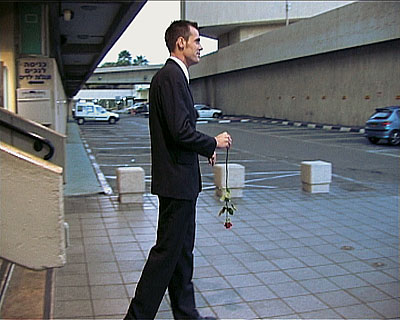| Revista Umělec 2003/3 >> ISREAL IN ACTION | Lista de todas las ediciones | ||||||||||||
|
|||||||||||||
ISREAL IN ACTIONRevista Umělec 2003/301.03.2003 Arlene Tuckerová | news | en cs |
|||||||||||||
|
This year from Nov. 20 to 23 the Israeli performance art festival Blurrr 4 took place in the area surrounding the flea markets in Jaffa. Unlike the previous three years of holding the festival in the closed spaces of a kibbutz, this year’s setting was opened up to the streets in a completely urban context. Amongst the shoppers, strollers, peddlers, and pigeons you felt the Mediterranean Sea and the history of Jaffa juxtaposed to the rims of modernity lying off in the near distant Tel Aviv. These undeniable and uncontrollable factors of routine, spontaneity, and intentions of the crowd and grounds challenged the artist on how their concept was portrayed. To see how the artists touched on a range of subjects with these sort of stipulations is what made this show so valuable.
Great Britain’s Roddy Hunter continued with his Symposium on Utopia series through the “Civil Twilight” piece that encompassed talking, strangers, and situational nature. “Between the ending of evening civil twilight on Monday, November 17, and the beginning of morning civil twilight on Thursday, November 20, I propose to undertake six three-hour walks around the perimeter of Yitzhak Rabin Square. I will walk continuously in both clockwise and anti-clockwise directions and invite anyone interested to walk and talk with me, discussing relationships between utopia, freedom, urbanism and art, public space and behavior, identity and memory. A subtle but pervasive presence, I will be recognizable by the repetitive insistence and deliberateness of my motion and by carrying a different colored rose (red, black, white or yellow) upside down on each walk. I also propose a small installation/exhibition in the physical environment of the biennial.” (RH) It’s important to note that civil twilight begins in the morning, and ends in the evening when the center of the sun is geometrically six degrees below the horizon. This is the limit at which twilight illumination is sufficient, under good weather conditions, for terrestrial objects to be clearly distinguished. Unlike Hunter’s attachment to scientific interaction there was Karin Mendelovici and Hilla Navok’s act of camouflaging themselves in the market with their piece First let’s work, then we’ll see. They describe it as a continuation of their Souvenir performance. “This time, we want to set a stall at the flea market. The stall will display all the visual and ideational material of the project as well as materials that were produced in and after the process. The ‘products’ will be put on sale like the rest of the items sold at the market, and not necessarily as ‘art objects’. The material includes, among other things, videocassettes, photos, albums, maps, CDs with interviews, monologues, conversations and musical pieces, clothing articles, etc.” (KM and HN) In a different kind of context, consumerism is challenged within the dynamics of the market in Bulgaria’s Vassya Vassileva performance. “Hazy Shopping is nothing but shopping. However simple and elementary we consider them to be, however restricted or historically limited the operations of ‘selling’ and ‘buying’ are, they possess certain hidden semantic levels. The object we try, taste, touch, smell, feel, evaluate, and discuss is becoming a center of communication in between us. Extrapolating objects from the market place is nothing but turning them into signifiers in the process of our interaction. Hazy Shopping is part of my search for the semiotics of the ‘shopping place,’ my attempt to outline the existing concepts of ‘shopping,’ its grammar and its syntax, to fill the gaps between the culturally established and the real codification of the market experience.” (VV) Needless to say the milieu was invigorating with Wladyslaw Kazmierczak and Ewa Rybska performing with dog muzzles on their faces or Hong O-Bong acting like a bird. In all there were twenty performances. While Andre Stitt educated us more on “akshuns,” The School of Visual Theatre played a musical-theatrical piece inspired by conjoined German brothers. Uri Kazenstein discussed dream behavior and progression and Beni Kori revealed himself within the depths of a suitcase. Performance art is never a let-down.
01.03.2003
Artículos recomendados
|
|||||||||||||







Comentarios
Actualmente no hay comentariosAgregar nuevo comentario